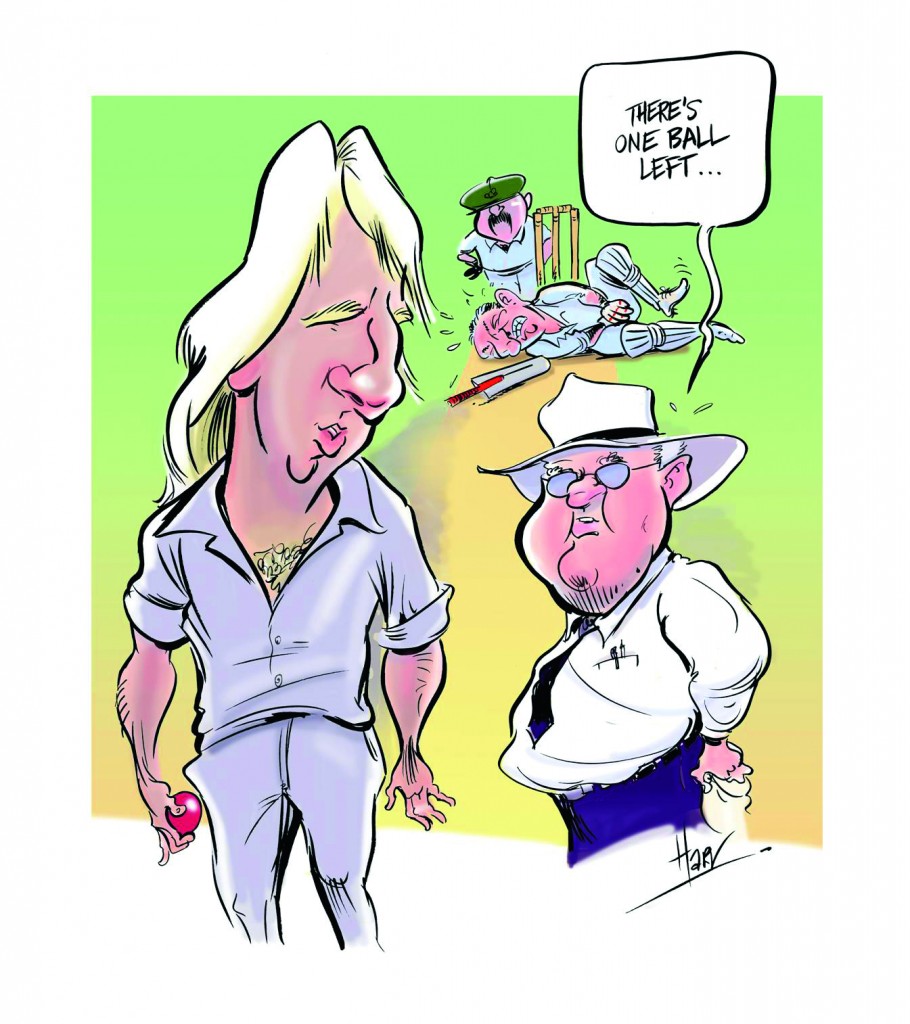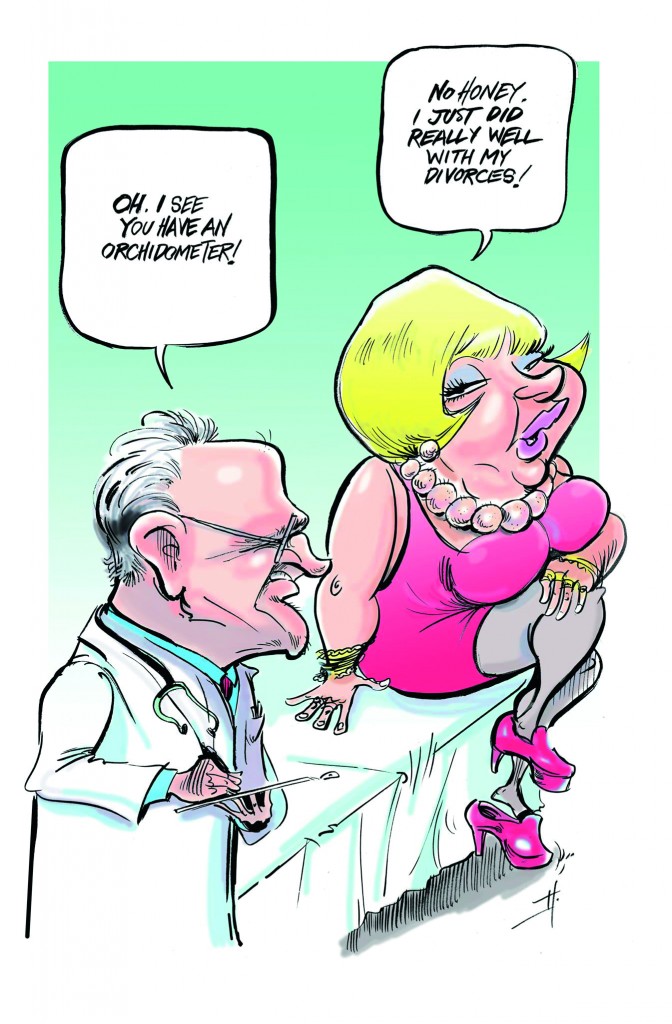It’s a sensitive area but someone has to talk about it and Bernie Crimmins ain’t afraid to.
In the last edition of ManSpace I talked about problems with the penis or old fella… call it what you may. Like Bogie and Becall or Laurel and Hardy you can’t talk about the penis without talking about the Orchestra Stalls, the Crown Jewels, the nuts, or the knackers. I am of course referring to the testicles here.
The big fear in this neck of the woods is the big C or Cancer. I have personally been touched in this area as my brother, the late and famous Peter Crimmins, Captain of the Hawthorn AFL club, passed away in 1976 at the ripe old age of 28 from metastatic testicular cancer. It was extremely sad to see as he put up a great fight against the odds of a disease that was fatal in well over 90% of cases at the time. With a bit of research and a re-jigging of the cancer drugs, a couple of years later the survival rate flipped over into the 90% range. So what can go wrong with the Goolies?
 BIG BALLS: LUMPS AND BUMPS IN THE BALL BAG (SCROTUM)
BIG BALLS: LUMPS AND BUMPS IN THE BALL BAG (SCROTUM)
I have a basic rule – get any lump in the testicle area checked out by a doctor. Don’t mess about. That requires you to be regularly checking yourself. That is best done in the shower because heat causes the balls to drop down which makes them easier to examine. Check one ball at a time by gently rolling it between your thumb, index and middle fingers. Do it at least once per month which will give you an idea of what it normally feels like. If you feel anything different then go and see your GP as soon as possible. He or she will have a feel of the testicles and surrounding areas and will probably order an ultrasound scan which will give the answer in most instances. Unfortunately, some males get scared when they feel something different in their testicles and go into denial, which inevitably delays the diagnosis. There is a good chance that it is nothing to worry about, but if it is, then time is of the essence.
Conditions that make your balls feel bigger include:
Testicular Cancer: It is the second most common form of cancer in males aged 18-39 thus it is largely a disease of young males. It can run in families and there is a 1 in 25 risk of getting cancer in the other ball in those with testicular cancer.
There are basically two types of testicular cancer and it is important to differentiate between the two. This is done after the diseased ball is removed via an orchidectomy (sounds like a gardening term) and sent away to be assessed by the pathologist. Forty percent of tumours are seminomas and they tend to occur in the slightly older age bracket of 30-60 years of age. After orchidectomy, these tumours are followed up with radiotherapy treatment. The other 60% of tumours are Non-Seminoma Germ Cell (NSGCT) tumours and occur in the younger age bracket of 18-40. These are followed up with anti-cancer drugs or chemotherapy. The issue of infertility post-orchidectomy and chemo or radiotherapy is now well addressed with sperm banks, which put your normal sperm away for another day.
Hydrocoele (pronounced hydro-seal): This is when fluid builds up in the sac around the testis. As the fluid builds up there is often a dragging sensation felt in the groin. There is a very thin bag inside the ball bag itself, which sits in front of and around the testis, called the tunica vaginalis (sounds a bit feminine). It is normally deflated and can’t be seen or felt; however, it can fill up with fluid and would look a bit like a plastic shopping bag with water in it. Wrap the bag around a ball and then you have what a hydrocoele looks like. The doctor can differentiate if the lump is solid like a tumour or fluid as in a hydrocoele by shining a light forwards from the back of your testes. If it is solid the light doesn’t shine through but if it is a hydrocoele it glows like a Chinese lantern (makes for a good party trick).
The main causes of a hydrocoele are:
Congenital: These are pretty common in kids as a connection persists between the tunica vaginalis (the bag) and the tummy so fluid comes down and fills up the bag. They sometimes close off and go away by themselves but at, or around two years of age, they are generally operated on to close off the connection.
Trauma: Any trauma to the balls may cause fluid to build up, a bit like an air bag effect. It will generally subside over a week.
Infection: Infection of the ball itself will cause fluid to build up. It will generally be tender and red as well, possibly with a fever.
Tumour: A testicular tumour may cause some fluid to build up. This sometimes makes it difficult to feel the testicle properly and so an ultrasound is required to get a good look.
Small hydrocoeles generally go away by themselves but larger or persistent ones may need to be operated on.
Varicocoele (pronounced varicko-seal): This is essentially a condition in which the veins taking blood out of the ball bag dilate up because the valves up higher in the groin don’t work properly. The varicocoele generally develops slowly but if they develop quickly then the presence of a kidney tumour needs to be excluded. That is why an ultrasound is a good idea. They can be removed surgically and should be if symptoms are present or if infertility is an issue.
Cysts of the Epididymis: These are probably the most common lumps that I see in blokes and they are completely benign and in most cases can be left alone as they often go away by themselves. The epididymis is like a can of wriggly worms which take the sperm from the testis, teaches them to swim and then stores them in its tail. A section can get blocked up and then a bubble or cyst develops which can get quite large, although most are pea sized. The cysts can generally be felt to be separate from the testis so reassurance regarding the lump not being a tumour can generally be achieved by having a good feel.
Inguinal Hernia: This hernia is a protrusion of the bowel through a weak point in the abdominal wall called the inguinal canal. A whole loop of bowel may push through and then push its way right down into the ball bag – not common, but it happens. Time to see a surgeon!
SORE BALLS
There can be a lot of reasons why your balls get sore. Let’s deal with a very common cause: trauma. In other words, copping one in the nuts… oh! I can see all you blokes cringing now. I think most males would have experienced this at least once in their life, either from sport or mucking around. It is a horrible, sickly pain. Cricket has provided its fair share of horror stories when it comes to this topic.
I love listening to former English batsman David Lloyd talking in a cricket DVD and on You Tube about a horrific incident when he was facing legendary Australian fast bowler, Jeff Thomson at his peak. He copped a savage blow in the nether regions from a spearing 160km/hour Thommo inswinger that split his totally inadequate plastic protector apart, trapping various parts of his anatomy in it. You have to laugh and almost cry at his candid description of the event. One of the scariest occasions in my cricketing life was realising after about four overs into my innings as an opening batsman that I had forgotten to put my protector on – and realising this just as the opening bowler was thundering in to bowl! I should have stepped away but instead, got my bat behind the ball, and in front of my balls and played it away and then sheepishly called for a box. Dad always taught me to protect my stumps – bugger the stumps on this occasion, there were more important structures to protect. An old cricket saying goes, “Never rub them, just count them.”
Trauma can result in a fracture (break) of the testicle and generally surgery is required to remove the testicle as it will inevitably not survive. Sometimes it is difficult to tell and an ultrasound scan will give a good picture of what damage has occurred. Most cases will result in just bruising.
Trauma is pretty obvious but what if your ball or balls get sore for no apparent reason? Go and get it checked. Just as I said with any lumps in the ball bag – go and see your Doc and get it sussed out. There are some serious conditions that need to be excluded when balls get sore. There is a condition called torsion of the testis which mainly affects young blokes in the teens to 20s age bracket, but it can happen at any age. It is a condition where the ball isn’t stuck down in the ball bag properly and is capable of twisting around like a ball hanging down on a piece of string. As it twists, the blood supply to the ball gets cut off and strangulates it, resulting in the ball dying. It is a medical emergency and needs to be attended to straight away as surgery is required to untwist it and reinstate the blood supply to save the ball. It will have to be stitched down to the ball bag to stop it happening again. Time is of the essence with this condition.
Just as cysts of the epididymis are probably the most common non-cancerous lump in the ball bag, the most common cause of a sore ball I see in GP land is infection or inflammation in the epididymis or Epididymitis – Monty Python fans will remember this word in one of their hilarious songs – the Medical Love Song. In a sexually active male, a sexually transmitted disease such as Chlamydia may be the cause. The ball itself can also get infected by various viruses or bacteria and this is termed orchitis. The mumps virus commonly causes this and sometimes fertility can be affected afterwards. Although it is said that testicular tumours are generally painless, I’d have to say that the blokes I have seen have had some discomfort or feeling of a dragging sensation.
 ITCHY BALLS
ITCHY BALLS
Itchy balls can be part of a general medical condition such as kidney or liver failure or generalised skin conditions such as eczema or psoriasis. Probably the most feared causes are the creepy crawly things such as the crabs (Pediculosis) or scabies. The Doc will have to look for the tell-tale eggs on the base of pubic hairs for crabs or the little burrows with scabies. Both are eminently treatable with various potions and lotions but they can easily spread to the bed partner who will also require treatment. It is also very important to wash the bed linen.
Fungi love the covered up and sweaty areas of the groin and cause an extremely itchy, red rash in the groin with a serpentine edge which may creep up onto the ball bag (jock itch). There are some good creams over the counter from the chemist like Hydrozole® which have an anti-fungal agent as well as some cortisone for the inflammation but they must be used religiously for at least two weeks. It is important to keep the area dry as fungi are like moulds and love moisture – use a hair dryer to dry the groin after showering (but don’t get caught doing it). There is another rash in the groin called Erythrasma which sometimes gets misdiagnosed as jock itch but it is caused by a bacteria (Corynebacterium) and needs an anti-bacterial antibiotic. The rash is more reddish-brown with a well-demarcated edge and occurs more commonly in diabetics.
SMALL BALLS
Whereas big or enlarged testicles may signify something sinister such as a tumour, small balls may signify a fairly silent but not uncommon condition called Klinefelter’s Syndrome (KS). KS is a male genetic condition in which an extra X chromosome is added to the normal XY male pairing. This extra X chromosome results in variable degrees of:
– learning and behavioural difficulties from infancy
– small balls
– infertility due to lack of sperm
– low male hormone (testosterone) levels with reduced facial and pubic hair
– behavioural issues
– breast development (moobs = man boobs)
– in later life – thin bones (osteoporosis) and a tendency towards the Metabolic Syndrome and Type 2 Diabetes.
The incidence of KS is strikingly high at one in 450 males which equates to over 1500 new cases per year. The big concern about this condition is that only around 10% are detected prior to birth because of genetic testing done for other reasons, e.g. to exclude the possibility of Down’s Syndrome in a mother-to-be over 35.
Unfortunately only another 25% are detected after birth, and a lot of these, are not diagnosed until their 30s when they are investigated for other issues such as infertility. This means 30 odd years without male hormones in his system and the consequential problems of this – a bit late unfortunately!
The lack of diagnosis has been put down to men firstly being reluctant to go and get check-ups, and secondly, on behalf of the doctors, due to their lack of awareness of the condition and a failure to check testicles. Let’s face it; most blokes don’t go around checking other blokes’ balls to compare size do they.
There is a wonderful piece of medical equipment called an orchidometer which looks like a necklace adorned with different sized testicles which gives an idea of the proper dimensions of the balls (I feel a cartoon coming on Harv).
If they are considered small then certain blood tests can be done to check it out and male hormone prescribed to get things back on track.
There you have it – testicles in a nut shell. This is an extremely important area of the male anatomy, easily checked and prone to some significant male health issues. May your balls swing free and painlessly, may they rise up in the cold and jingle jangle in the warmth. And may you stay happy and healthy!
Go Hawks!
Dr Bernie “Buna” Crimmins, #51




